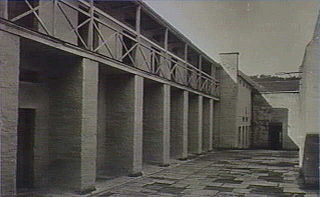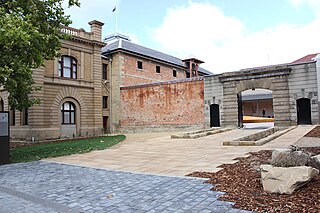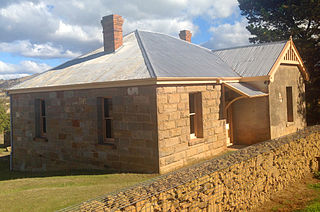Related Research Articles

Risdon Cove is a cove located on the east bank of the Derwent River, approximately 7 kilometres (4 mi) north of Hobart, Tasmania. It was the site of the first British settlement in Van Diemen's Land, now Tasmania, the smallest Australian state. The cove was named by John Hayes, who mapped the river in the ship Duke of Clarence in 1794, after his second officer William Bellamy Risdon.

Sorell is a town in Tasmania, Australia, north-east of Hobart. It is located on the Tasman Highway at the junction with the Arthur Highway. Sorell is one of Tasmania's oldest towns, being first settled in 1808 as a small farming community and becoming an official township in 1821. At the 2006 census, Sorell had a population of 1,546, and at the 2011 census, a population of 2,476. and at the 2016 census, a population of 2,907.

North Hobart is a suburb of the city of Hobart, Tasmania, Australia. As its name suggests, it lies directly north of the CBD.

Sullivans Cove is on the River Derwent adjacent to the Hobart CBD in Tasmania.

The Cascades Female Factory, a former Australian workhouse for female convicts in the penal colony of Van Diemen's Land, is located in Hobart, Tasmania. Operational between 1828 and 1856, the factory is now one of the 11 sites that collectively comprise the Australian Convict Sites, listed on the World Heritage List by UNESCO.

HMS Rattlesnake was an Atholl-class 28-gun sixth-rate corvette of the Royal Navy launched in 1822. She made a historic voyage of discovery to the Cape York and Torres Strait areas of northern Australia.

Lawrence Kavenagh was a convict bushranger known for escaping from Port Arthur, Van Diemen's Land, with Martin Cash and George Jones.

Jane Franklin, known as Lady Franklin after her husband's knighthood, was the second wife of the English explorer Sir John Franklin. During her husband's period as Lieutenant-Governor of Van Diemen's Land, she became known for her philanthropic work and her travels throughout south-eastern Australia. After John Franklin's disappearance in search of the Northwest passage, she sponsored or otherwise supported several expeditions to determine his fate.

The Tasmanian Museum and Art Gallery (TMAG) is a museum located in Hobart, Tasmania. The museum was established in 1846, by the Royal Society of Tasmania, the oldest Royal Society outside England. The TMAG receives 400,000 visitors annually.

Cadbury's Chocolate Factory is a working chocolate factory belonging to the Australian division of international confectionery company Cadbury, and is located in Claremont, Tasmania. Despite being an active production facility, Cadbury's Claremont has a rich history with 18 heritage listed buildings on the site. The factory still features pure granite "conching" machines which are over 60 years old but are still in use. Due to its long history, and the general appeal of chocolate, the factory was a major Tasmanian tourism attraction for families until its on-site visitor centre closed in 2015.

Ross is a historic town in the Midlands of the state of Tasmania in Australia. On the Macquarie River, Ross is located 78 km south of Launceston and 117 km north of Hobart. The town is listed on the Register of the National Estate and is noted for its historic bridge, original sandstone buildings and convict history.
Buckingham Land District is one of the twenty land districts of Tasmania which are part of the Lands administrative divisions of Tasmania. It was formerly Buckingham County, one of the 18 counties of Tasmania and one of the first eleven proclaimed in 1836 and is bordered to the north by the River Derwent, and to the south by the Huon River. It includes Bruny Island. Hobart is located in the county. It was named after the then county of England.

HMS Anson was a 74-gun third rate ship of the line of the Royal Navy, launched on 11 May 1812 at Hull.
For the Term of His Natural Life is a 1927 Australian film, based on the novel by Marcus Clarke, directed, produced and co-written by Norman Dawn. It was the most expensive Australian silent film ever made and remains one of the most famous Australian films of the silent era.
The Lady Outlaw is a 1911 Australian silent film set in Van Diemen's Land during convict days.

William Carter was the first Mayor of Hobart.

The Ross Female Factory, a former Australian workhouse for female convicts in the penal colony of Van Diemen's Land, is located in the village of Ross, in the midlands region of Tasmania. Operational between 1848 and 1854, the factory is now one of the 11 sites that collectively comprise the Australian Convict Sites, listed on the World Heritage List by UNESCO.
Holy Trinity Church is a former Anglican, and now Greek Orthodox, church in North Hobart, Tasmania.

The New Zealand Company was a 19th-century English company that played a key role in the colonisation of New Zealand. The company was formed to carry out the principles of systematic colonisation devised by Edward Gibbon Wakefield, who envisaged the creation of a new-model English society in the southern hemisphere. Under Wakefield's model, the colony would attract capitalists who would then have a ready supply of labour—migrant labourers who could not initially afford to be property owners, but who would have the expectation of one day buying land with their savings.
George Jones was a convict bushranger known for escaping from Port Arthur, Van Diemen's Land, with Martin Cash and Lawrence Kavenagh.
References
- ↑ Life in Van Diemen's Land Factories
- ↑ "HIRING DEPOT, BRICKFIELDS". The Observer . Hobart, Tas: National Library of Australia. 31 October 1845. p. 1. Retrieved 29 February 2012.
- ↑ "VISITING JUSTICE REPORT". Colonial Times . Hobart, Tas.: National Library of Australia. 29 October 1844. p. 4. Retrieved 29 February 2012.
- ↑ "Brickfields Hiring Depot". Archived from the original on 6 July 2012. Retrieved 29 February 2012.